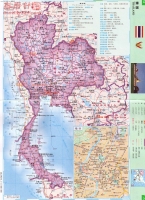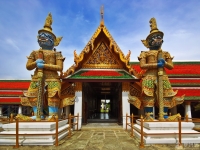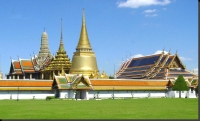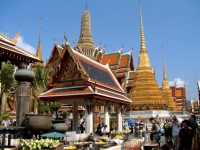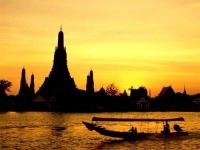東南亞:
|
| 泰國 Thailand 首都:曼𠔌 國家代碼: th |
|
泰王國(The Kingdom of Thailand)。簡稱泰國(Thailand,Thai)是東南亞的一個國傢,東臨老撾和柬埔寨,南面是暹羅灣和馬來西亞,西接緬甸和安達曼海。在1949年5月11日以前,泰國的名稱是暹羅。
國旗 呈長方形、長與寬之比為3∶2。由紅、白、藍三色的五個橫長方形平行排列構成。上下方為紅色,藍色居中,藍色上下方為白色。藍色寬度相等於兩個紅色或兩個白色長方形的寬度。紅色代表民族和象徵各族人民的力量與獻身精神。泰國以佛教為國教,白色代表宗教,象徵宗教的純潔。泰國是君主立憲政體國傢,國王是至高無上的,藍色代表王室。藍色居中象徵王室在各族人民和純潔的宗教之中。 國徽 泰國國徽是一個極富宗教神秘色彩的圖騰圖案。深紅色的大鵬是泰國民間傳說中鷹面人身的神靈。 國花 稻花(禾本科) 語言 泰語是泰國的官方語言。屬壯侗語係侗臺語族。泰語是一種分析型語言,不同的聲調有區分詞彙和語法的作用。 泰語與臺語 泰語與臺語都是從英語的Thai翻譯而來。英語的Thai可以指一個語言,也可以指一組語言。一般來說,在以中文寫就的文章中,表示一個語言時寫作泰語,表示包含泰語在內的一組語言時寫作臺語。 貨幣 銖(baht)符號:THB 宗教 佛教為國教,其信徒占95%,其次伊斯蘭教占3.8%,基督教占0.5%,其他0.7%。 面積 513,115平方公裏(世界第49名) 人口 總人口:65,444,371(世界第19名) 人口密度:127/km2(世界第59名) 民族 全國共有30多個民族。泰族為主要民族,占人口總數的40%,其餘為老撾族,華族,馬來族,高棉族,和苗、瑤、桂、汶、剋倫、撣、塞芒、沙蓋等山地民族。泰語為國語。94%的居民信仰佛教,馬來族信奉伊斯蘭教,還有少數信奉基督教、天主教、印度教和錫剋教。 首都 曼𠔌(Bangkok),註册人口584萬(2006年12月)。 國傢元首 國王普密蓬·阿杜德(BHUMIBOL ADULYADEJ),拉瑪九世王。1946年6月9日即位,1950年5月5日加冕。 國際電話區號 66 國際域名縮寫 TH 政體 泰王國憲法規定:泰王國是以國王為國傢元首的民主體製國傢。 重要節日 宋幹節(公歷四月十三日至十五日);水燈節(泰歷十二月十五日);國慶日(國王誕辰日,公歷十二月五日)。 簡況 位於中南半島中南部。與柬埔寨、老撾、緬甸、馬來西亞接壤,東南臨泰國灣(太平洋),西南瀕安達曼海(印度洋)。熱帶季風氣候。全年分為熱、雨、涼三季。年均氣溫24~30℃。 1238年開始形成較為統一的國傢。先後經歷了素可泰王朝、大城王朝、吞武裏王朝和曼𠔌王朝。原名暹羅。16世紀,葡萄牙、荷蘭、英國、法國等殖民主義者先後入侵。1896年英法簽訂條約,規定暹羅為英屬緬甸和法屬印度支那間的緩衝國。暹羅成為東南亞唯一沒有淪為殖民地的國傢。19世紀末,拉瑪四世王開始實行對外開放。五世王藉鑒西方經驗進行社會改革。1932年6月,拉瑪七世王時期,民黨發動政變,改君主專製為君主立憲。1939年更名泰國,後經幾次更改,1949年正式定名泰國。 同北京時差 比格林尼治時間早7小時;比北京時間晚1小時 【地理】 國境大部份為低緩的山地和高原。地形多變,可分為西﹑中﹑東﹑南四個部份。 泰國西部為山區,是喜瑪拉雅山脈的延伸他念他翁山脈為主的山地,一直由北嚮南走嚮。位於清邁府的英坦昂峰(海拔2,576米)是泰國的最高峰。 東北部是呵叻高原,這裏夏季極幹旱,雨季非常泥濘,不宜耕作。中部是昭披那河(即湄南河)平原。由曼𠔌嚮北,地勢逐步緩升,湄南河沿岸土地豐饒,是泰國主要農産地。曼𠔌以南為暹羅灣紅樹林地域,漲潮時沒入水中,退潮後成為紅樹林沼澤地。泰國南部是西部山脈的延續,山脈再嚮南形成馬來半島,最狹處稱為剋拉地峽。 另外,泰國的一般大衆習慣將國傢的疆域比作大象的頭部,將北部視為“象冠”,東北地方代表“象耳”,暹羅灣代表“象口”,而南方的狹長地帶則代表了“象鼻”。 氣候方面,泰國屬於熱帶季風氣候。常年溫度不下攝氏18℃,平均年降水量約1000毫米。11月至2月受較涼的東北季候風影響比較乾燥,3月到5月氣溫最高,可達攝氏40-42℃,7月至9月受西南季候風影響,是雨季。10月至12月偶有熱帶氣旋從南中國海經過中南半島吹襲泰國東部,但在暹羅灣形成的熱帶氣旋為數甚少且弱。 【歷史】 泰國目前之地方,於幾千年前即有人居住,但並不是泰族。據一般的瞭解,泰族是發源於中國的南部,而於公元第十一與十二世紀纔移居到目前的泰國。 考古學家在泰國東北部的曼清發現許多古老的遺跡,證明泰國的文化起源於大約五千年前的青銅文化期。史前正確的資料至目前仍然不明,因為泰國的風俗和殘存的文化一直在變動,而且很少記載下來,尤其在第十八世紀,由於受到外族的侵略而毀了不少早期的文物。 公元第十三世紀末,泰國史上的第一位最英明的國王――盂萊大帝,就在目前泰國北部的清萊與清邁一帶建立了一個繁榮的社會,當時所興建的廟宇顯示受到佛教很大的影響。一般而言,泰國除了受到印度佛教的影響外,盂族、高棉族對泰國的影響也不小。泰國最大的民族是泰族,這些住在北部的民族,早期已能夠自給自足,但他們的軍事力量都相當薄弱,在公元十三世紀初,終被鄰國吳哥王朝的高棉族所徵服,不過,這段人侵時間並不長,泰族在1238年打了一次勝仗,從高棉人手中奪回素可泰城,並建立起泰國歷史上的第一個王朝,定都素可泰。 素可泰在巴利文裏的意思是“幸福的黎明”。當時,泰國還沒有統一的文字,因此用“素可泰”作為第一個王朝的年號,以表明新時期的開始。素可泰王朝的君主為蘭甘杏大帝,他被泰國人尊稱為“泰國之父”。其最大的貢獻,是將國內通行的真臘(即高棉)文字,改創成泰國自己的文字。約在1283年,泰文開始在全國流行。蘭甘杏大帝受人尊重的另一原因,是他團结各族,以平等方式對待泰族以外的少數民族如高棉人、馬來人和華人。他本身亦崇尚佛教,並派信徒到錫蘭(今斯裏蘭卡)學習佛經,讓他們回國後宣揚小乘佛教教義。素可泰王朝建立後,國泰民安,其勢力開始嚮湄南河盆地流域擴展。到公元十四世妃初期,素可泰王朝的勢力,已經影響整個馬來半島和老撾(即遼國)一帶。蘭甘杏去世後,強盛一時的王朝逐漸衰弱下去。此時,泰團東部的一股泰族勢力,正在日益肚大,很快蔓延到中部地區。 1347年,一名太守的女婿拉瑪鐵菩堤,結集兵力在湄南河和巴塞河的匯合地方,建立了一座新城,取名阿育他耶(華人稱之為大城),並立號為王,這就是後來的大城王朝。拉瑪鐵菩堤稱王後,立即展開外交和軍事攻勢,有意占領整個湄南河流域,包括北部的素可泰王朝。他的精明思想和治國才能,為大城王朝的基業奠定了基礎,且取代了素可泰王朝的地位。大城王朝維持了四百多年,經歷三十三位君主。十五世紀末,繞非洲好望角至東方之航綫開闢後,歐洲人開始前往泰國通商。首先到來的是葡萄牙人,他們占領了馬六甲一帶後,於1512年抵達大城。從此,荷蘭人、英國人和法國人亦相繼而來,企圖在泰國這塊富饒土地上獲得利益。此外,泰國與鄰國緬甸在這一時期經常發生衝突,持續了一段很長時間。 1767年,緬軍再次攻入大城,城內的王宮、佛寺、民房和藝術寶藏均被摧毀。昔日的輝煌殿閣,如今衹存殘垣斷壁,荒草遍地,謹供遊人憑吊而已。大城王朝的京城在1767年陷落後,緬軍仍留下士兵駐守,以鎮壓泰國人的反抗。但在泰國東南沿海一帶,卻崛起了一支抗緬部隊,這支部隊的主將原是大城王朝的將領鄭信(在中國史書稱鄭昭)。鄭信是華人後裔,其父鄭鏞原籍廣東澄海,由於傢貧纔往泰國謀生,並與一泰族女子結婚,於1734年誕下鄭信。鄭信當日在大城被侵時,率領隨從逃出大城,於泰國東南的羅勇府建立基地,組織力量,半年後部隊分乘戰船,沿湄南河而上,首先攻破了西岸吞武裏,繼而乘勝追擊,到大城與靦軍展開血戰,最後終於收復渝陷的大城。鄭信進城,目睹昔日首都大城衹留下一片焦土,故决定遷都湄南河西岸的吞武裏,建立起泰國的第三涸王朝一吞武裏王朝,並削減了據地稱雄的其他勢力,收復失地,統一泰國。然而,宮廷內部的爭權奪利,很快又再次出現。鄭信在執政後期傳說因妃嬪爭寵而精神錯亂,並於1782年一次倒戈事件中被殺。另一說稱鄭信被亂黨睏於宮中,後死在囚中,時為四十八歲。吞武裏王朝就此覆滅,為時衹有十五年。後人為紀念鄭王的豐功偉績,特在吞武裏區域內建立鄭王廟,並在大羅鬥圈廣場中央為鄭倩塑造了一座紀念碑,碑上聳立着鄭信的騎馬戎裝銅像,策馬揮劍,極之英武。每年12月28日即鄭王加冕之日,循例在銅像地區舉行鄭王朝祭大典,並封鎖附近公路,舉行兩晝夜的文娛活動。 鄭信的王朝被推翻後,其手下部將昭披耶節基登上王位,他就是拉瑪一世王(拉瑪是取自泰族民間傅說的一位英雄人物),也就是目前泰國的王朝,即當今皇上蒲美蓬大帝(拉瑪九世王)之先祖。由於地方太小,加上國防上的理由,拉瑪一世王把國都從吞武裏移到昭拍耶河東岸,於是曼𠔌就成了泰國史上的第四個國都。至此泰國開始得到安定,曼𠔌王朝或稱節基王朝或拉瑪王朝至今已逾二百多年,而國都仍然是曼𠔌。 拉瑪二世王,1809年登基,在位十五年,曾遣使赴北京二次,時為清朝道光及嘉慶年間。拉瑪三世王(在位公元1824至1851年)開始又對西洋各國開放,甚至當時美國也派了首任官員出使泰國,接著美國的傳教士也來了,他們同時也帶來了印刷術,經過改良後使泰國開始有了泰文的印刷,另西歐醫學、造船學也傳人了泰國。拉瑪四世王蒙庫是節基王朝的英明國王之一,是泰國歷史上第一位接受西方學術思想的國君,精佛學,重科學,知識廣博。他通曉許多語言。如拉丁文、英文等。他是第一個准許平民可以親近的國王。為了抵抗西方國傢的侵人,他與鄰國化幹戈為玉帛,又與西方國傢建立外交關係。他曾寫信給美國南北戰爭時期的林肯總統,聲明以物質支援他。王位傳到拉瑪五世王,也就是泰國史上最著名的朱拉隆功大帝,他從事大力的改革和積極的建設。他廢除奴隸制度,興建學校、博物館、國立圖書館,並在國內修建了第一條鐵路,發展道路係統,創辦郵電局和其他現代化設施。歷史學家稱他的執政時期為“維新時代”,實際上可說是泰國現代化的開端。他是引導泰國現代化的英明國王,在位直到公元1910年。朱拉隆功於1910年逝世,後人為紀念他的功績,在曼𠔌國會大廈前的廣場擺放他的銅像。每年10月23日他的祭辰之日,此廣場都有紀念活動舉行。朱拉隆功去世之後,英、法便在泰國各自割分勢力範圍。由於拉瑪六世王曾在英國劍橋求學,同時也曾服役於英軍,所以第一次世界大戰時,泰國就派兵到法國支援同盟國。大戰結束後,暹羅也就加人了國際聯盟。第一次大戰以前’泰國人是衹有名字而沒有姓氏的。大戰後拉瑪六世王就宣佈每個人可有姓,因此至今泰國人雖然有姓但很少用,而通常衹叫名字。隨著世界潮流之趨勢,皇族的權力漸漸被憲法所限製,拉瑪七位王執政後,結束了是達七百多年的君主專製,在1932年12月10日開始實行君主立憲,頒布憲法,於是泰國成了君主立憲的國傢。由國會組織政府處理國傢事務,一直至今。 第二次世界大戰期間,1940年泰國為了保持國土的完整,勉強與日本簽訂友好條約,次年日本軍隊就進入泰國。泰國軍民感到對日本抵抗並非上策,遂加入軸心國。戰爭結束,雖然軸心國(日本、德國等)失敗,但泰國乃因“非原始發戰國且沒有出兵”而仍被邀加入聯合國,目前泰國國內駐有聯合國的分支機構。拉瑪八世王,是五世王王子公摩鑾宋卡王子之長公子。1934年繼承王位,時因第二次世界大戰起,隨王太後駐蹕瑞士,1945年回泰準備舉行登基大典。不幸翌年6月9日中槍駕崩。年甘,在位12年。 當今王上拉瑪九世王今年聖壽六秩晉九,1927年12月5日在美國麻省康畢城蒙奧本醫院誕生,本生爵稱蒲美蓬·亞偷耶益德親王。1934年,拉瑪七世王駐蹕倫敦宣佈遜位,因無所出,宮廷按譜立嗣君,奏請王兄繼承大統,號稱頌緑巴拉民他拉瑪哈南他瑪希隆陛下,簡稱拉瑪八世王。1935年,當今王上以王上禦弟身份加封昭華蒲美蓬亞倫耶益德王弟。1946年6月9日,拉瑪八世王突告駕崩,當今王上以先王無嗣,按王族繼承法規定宣佈登基繼承大統,號稱拍昭裕華蒲美蓬?亞倫耶益德陛下,簡稱拉瑪九世王。1950年,王上自國外回泰京都,三月欽命舉行先王火葬禦禮,同年四月甘八日賜定於十八涌宮殿舉行大婚慶典,敕令册封詩麗吉?吉滴耶功女親王為王後,號稱頌緣拍拉·尼詩麗吉王後。1951年4月5日王後在瑞士洛桑之蒙瑞司醫院院盆,誕生第一位公主,稱號昭華鳥汶樂叻查幹耶?詩麗越他那攀哇哩公主。1952年7月28日皇儲太子誕生。1955年4月6日拍貼公主誕生。1957年7月4日朱拉蓬公主誕生。1956年10月22日王上剃度出傢,皈依佛門,為期十五日,守戒於玉佛寺,政務方面敕命王後代為主政。還俗之後,鑒於王後秉政期間諸事有條不紊,循依古例敕封王後為正王後之位。溯自1946年,王上秉政以來,愛國愛民之聖懷,為國為民之聖務包羅萬象,幾乎日無稍懈,宣慰四方,視察民瘼,垂詢當地官府軍警詳情,賜問各地民教衛生情況及生活實況。節基王朝第九世王蒲密蓬?阿倫耶勒陛下於1946年6月9日登基以來,至今已五十年,他是泰國有史以來在位世界最長的一位盛世明君。幾十年來,王上以他超人的智慧,聖躬不屈不饒的毅力,為泰國的民主自由和繁榮進步建立了不朽的功績。王上以堅定的决心,高度的熱誠和德澤廣被的親和力,把全國經濟地位不同、宗教信仰不同、種族背景不同的各民族人民團结成一體,朝嚮經濟和社會建設的總目標。1996年6月9日是王上登基滿五十周年之日,泰國全體臣民都以歡欣鼓舞的心情,熱烈舉行盛況空前的崇慶活勤,以頌揚王上登基五十周年的愛民若赤、聖澤廣被和偉大仁政,表達全國萬民感戴王恩浩蕩的赤誠。 【政 治】 實行君主立憲製。國王普密蓬·阿杜德是國傢元首、武裝部隊最高統帥。1946年6月9日繼位,是當今世界在位最久的君主。 二戰後,軍人集團長期把持政權,局勢動蕩。上世紀90年代軍人淡出政壇後,政壇黨派林立,紛爭不斷,政府更迭頻仍。 2001年,電訊業巨子塔信創建泰愛泰黨,在大選中贏得下議院過半席位,組閣執政。2005年2月,泰愛泰黨在大選中贏得下議院500個議的席中377席,塔信蟬聯總理。 2005年9月起,泰社會掀起“反塔”運動,政局出現動蕩。為緩解政治壓力,塔信於2006年2月解散議會,提前舉行下議院選舉,政府轉為看守內閣。泰愛泰黨在4月的大選中再次贏得過半選票,但因三大反對黨--民主黨、泰國黨、大衆黨抵製大選,導致國會無法在憲法規定時間內成立。5月8日,憲法法院裁定4月大選中存在違憲問題,宣佈選舉結果無效。9月19日,以陸軍司令頌提為首的“行政改革委員會”發動軍事政變,廢除1997年憲法,解散國會、內閣,接管政權。10月1日,普密蓬國王禦準臨時憲法,任命原樞密院大臣素拉育·朱拉暖出任新總理,8日禦準新內閣,12日禦準立法議會,代行國會職責。政變發生後,他信旅居海外,宣佈辭去泰愛泰黨黨首職務,退出政壇。2007年末,由他信親信沙馬·順達衛領導的人民力量黨在泰國大選中勝出,沙馬·順達衛成為泰國新任總理。 【憲 法】 現行憲法為臨時憲法,於2006年10月1日獲普密蓬國王禦準頒布實施。分為國王、公民權利、自由與義務、議會、內閣、法院、新憲法製定、全國大選等39條。 【議 會】 全稱立法議會。2006年9月19日,泰“行政改革委員會”發動軍事政變,宣佈暫時接管國傢行政權力,廢除1997年憲法,解散看守政府和國會。10月1日,普密蓬國王禦準臨時憲法。11日根據臨時憲法任命242名立法議會議員,25日任命米猜·雷初攀為立法議會主席,乍蘭·軍拉瓦尼上將、普乍尼·塔納瓦拉尼(女)為副主席。2007年末,由他信親信沙馬·順達衛領導的人民力量黨在泰國大選中勝出,沙馬·順達衛成為泰國新任總理(兼任防長),新一屆36人內閣名單已由普密蓬國王批準通過。 立法議會現代行國會職責,下設24個專門委員會,主要負責審議製定有關法律文件,對政府政策和工作進行監督。立法議會主席兼任國民大會主席,有權任命200名製憲會議委員。 【政 府】 政府由一名總理和不超過35名部長組成。 現政府於2006年10月成立。34位閣員名單如下:總理素拉育·朱拉暖(Gen.Surayud Chulanont)、副總理科實·班扁叻(Mr.Kosit Punpiemrat)、副總理派汶·瓦塔納西裏他(Mr.Paiboon Wattanasiritham)、國務部長坤仁提帕瓦迪·梅莎宛(Kunying Dhipavadee Meksawan)、國務部長提拉帕·社裏朗訕(Mr. Thirapat Serirangsan)、國務部長巴實·科威拉軍(Mr. Prasit Kovilakool)、國防部長汶洛·頌塔上將(Gen. Boonrod Somtad)、財政部長察隆頗·素桑甘(Mr.Chalongphob Sussangkarn)、財政部副部長頌邁·帕實(Mr.Sommai Phasee)、外交部長尼特·披汶頌堪(Mr. Nitya Pibulsonggram)、外交部副部長雄威倪·孔詩裏(Mr. Sawanit Kongsiri)、旅遊和體育部長素威·耀瑪尼(Mr. Suwit Yodmanee)、社會發展和人類安全部長派汶·瓦塔納希裏探(Mr. Paibool Wattanasiritham)、社會發展和人類安全部副部長蓬得·炳巴提(Mr.Poldej Pinprateep)、農業與合作部長提拉·素達布(Mr. Thira Sutabot)、農業與合作部副部長隆叻·伊沙朗軍·納·阿育他耶(Mr. Rungruang Isarangkura Na Ayuthaya)、交通部長提拉·浩乍侖上將(ADM. Thira Hao-Charoen)、交通部副部長訕盛·翁猜務(Mr. Sansern Wongcha-um)、自然資源和環境部長格森·沙尼翁·納·阿育他耶(Mr. Kasem Sanitwong Na Ayuthaya)、信息技術和通訊部長西提猜·頗凱烏東(Mr. Sitthichai Pokai-udom)、商業部長格蓋·吉拉派(Mr. Krirkkrai Jeerapath)、商業部副部長奧拉努·歐沙塔暖(Mrs.Oranuj Osatananda)、能源部長比亞沙瓦·阿瑪拉南(Mr. Piyasvasti Amranand)、內政部長阿裏·翁阿拉亞(Mr. Aree Wongsearaya)、內政部副部長班雅·占塞納(Mr. Bunyat Junsena)、司法部長禪猜·裏奇吉塔(Mr. Charnchai Likhitjitta)、勞工部長阿派·占塔納尊格(Mr. Apai Chandanachulaka)、文化部長坤仁凱西·西阿倫(Khunying Khaisri Sri-aroon)、科技部長勇育·育塔翁(Prof.Dr. Yongyuth Yuthawongs)、教育部長威集·西沙安(Mr. Wijit Arisa-an)、教育部副部長瓦拉功·訕郭社(Mr.Varakron Samakses)、衛生部長蒙空·納·宋卡(Mr. Mongkol Na Songkhla)、衛生部副部長莫拉哥·功格社(Mr.Morakot Kornkasem)、工業部長科實·班扁叻(Mr.Kosit Punpiemrat)、工業部副部長比亞布·春威占(Mr. Piyabutr Cholvijarn)。 【行政區劃】 泰國全國共有76個一級行政區,其中包括75個“府”(changwat)與直轄市的首都——曼𠔌。這76個行政區一般被劃分為5個主要地區,包括北部、東北部、東部、中部與南部地區,每個府都是以其首府(mueang)作為該府的命名。在府底下,又有更小的次級行政區劃,稱為“區”(amphoe)與“次區”(king amphoe),根據2000年時的統計,泰國全國共有795個區與81個次區。至於首都曼𠔌的次級行政區則與各府的次級行政區在命名上有點出入,稱為“khet”總數達50個。 北部地區 清邁府(Chiang Mai) 清萊府(Chiang Rai) 甘烹碧府(Kamphaeng Phet) 南邦府(Lampang) 南奔府(Lamphun) 湄宏順府(Mae Hong Son) 北欖坡府(Nakhon Sawan) 楠府(Nan) 拍天府(Phayao) 碧差汶府(Phetchabun) 披集府(Phichit) 彭世洛府(Phitsanulok) 帕府(Phrae) 素可泰府(Sukhothai) 來興府(Tak) 烏泰他尼府(Uthai Thani) 程逸府(Uttaradit) 東北地區 安納乍能府(Amnat Charoen) 武裏喃府(Buriram) 猜也賁府(Chaiyaphum) 加拉信府(Kalasin) 坤敬府(Khon Kaen) 黎府(Loei) 嗎哈沙拉堪府(Maha Sarakham) 莫拉限府(Mukdahan) 那空拍儂府(Nakhon Phanom) 呵叻府(Nakhon Ratchasima) 廊磨喃蒲府(Nong Bua Lamphu) 廊開府(Nong Khai) 橫逸府(Roi Et) 色軍府(Sakon Nakhon) 四色菊府(Si Sa Ket) 素輦府(Surin) 烏汶府(Ubon Ratchathani) 莫肯府(Udon Thani) 益梭通府(Yasothon) 東部地區 北柳府(Chachoengsao) 尖竹汶府(Chanthaburi) 春武裏府(Chon Buri) 巴真府(Prachin Buri) 羅勇府(Rayong) 沙繳府(Sa Kaeo) 桐艾府(Trat) 中部地區 紅統府(Ang Thong) 大城府(又稱為阿如他耶,Phra Nakhon Si Ayutthaya) 曼𠔌(Bangkok,又稱為Krung Thep Maha Nakhon,為一直轄市) 猜納府(Chai Nat) 北碧府(Kanchanaburi) 華富裏府(Lop Buri) 坤西育府(Nakhon Nayok) 佛統府(Nakhon Pathom) 暖武裏府(Nonthaburi) 巴吞他尼府(Pathum Thani) 佛丕府(Phetchaburi) 班武裏府(Prachuap Khiri Khan) 叻丕府(Ratchaburi) 北欖府(Samut Prakan) 竜仔厝府(Samut Sakhon) 夜功府(Samut Songkhram) 北標府(Saraburi) 信武裏府(Sing Buri) 素攀府(Suphan Buri) 【司法制度】 屬大陸法係,以成文法作為法院判决的主要依據。司法係統由憲法法院、司法法院、行政法院和軍事法院構成: 憲法法院主要職能是對部分議員或總理質疑違憲、但已經國會審議的法案及政治傢涉嫌隱瞞資産等案件進行終審裁定,以簡單多數决定裁决結果。由1名院長及14名法官組成,由上議院議長提名呈國王批準,任期9年。 行政法院主要審理涉及國傢機關、國有企業及地方政府間或公務員與私企間的訴訟糾紛。行政法院分為最高行政法院和初級行政法院兩級,並設有由最高行政法院院長和9名專傢組成的行政司法委員會。最高行政法院院長的任命須經行政司法委員會及上議院同意,由總理提名呈國王批準。 軍事法院主要審理軍事犯罪和法律規定的其他案件。 司法法院主要審理不屬於憲法法院、行政法院和軍事法院審理的所有案件,分最高法院(大理院)、上訴法院和初審法院三級,並設有專門的從政人員刑事廳。另設有司法委員會,由大理院院長和12名分別來自三級法院的法官代表組成,負責各級法官任免、晉升、加薪和懲戒等事項。司法法院下設秘書處,負責處理日常行政事務。 【政 黨】 截至2006年12月,共有44個政黨在選舉委員會登記註册。主要政黨有: 1、泰愛泰黨(THAI RAK THAI PARTY)。1998年7月24日成立。代黨首乍都隆·采盛。秘書長素立亞·曾隆樂吉。執委61人。在全國設有10個黨部。黨員1439,4404人。 2、民主黨(DEMOCRAT PARTY)。1946年4月6日成立。黨首阿披實·威差奇瓦。秘書長素帖·特素班。執委49人。在全國設有194個黨部。黨員407,4792人。 3、泰國黨(CHARTTHAI PARTY)。1982年7月8日成立。黨首班漢·信拉巴阿差。秘書長巴帕·普素圖。執委49人。在全國設有14個黨部。黨員260,0731人。 4、大衆黨(MAHACHON PARTY)。1998年2月10日成立(原名公民黨,2004年7月19日改為現名)。黨首沙南·卡鐘巴薩。秘書長汶樂·蓋布希。執委34人。在全國設有10個黨部。黨員230,4324人。 5、皇傢人民黨(ROYAL PEOPLE PARTY)。2006年1月10日成立。黨首沙諾·天通。秘書長素拉蓬· 宋威瑟。執委7人。黨員19萬人。 【重要人物】 普密蓬·阿杜德國王:拉瑪王朝第九世王。1927年12月5日生於美國。曾在瑞士攻讀政治和法律。1946年6月即位,1950年5月5日加冕。重視農業,經常視察農村,贊助實施了土地改革、水利、優良品種培植等多項農村發展計劃。愛好攝影、吹薩剋斯管、羽毛球和帆船運動。著有《雨絲》等多首著名樂麯並出版過樂麯專輯。1950年4月與詩麗吉王後結婚,育有子女四人:烏汶叻公主、哇集拉隆功王儲、詩琳通公主、朱拉蓬公主。 總理沙馬·順達衛。1935年出生在曼𠔌的富裕家庭,畢業於當地著名的法政大學。他於1968年加入民主黨,以曼𠔌為根據地,開始了自己的政治生涯。幾十年來,沙馬曾在8屆內閣任職,先後擔任過副總理、內政府長、交通部長等職。從1968年起,他擔任了20多年的國會議員,並在1979年創建了泰國民衆黨,擔任黨主席職務。他2006年當選為參議員,但是隨着當年的軍事政變,上議院也自動解散了。後來沙馬加入了泰國人民力量黨,去年被選為該黨主席,帶領人民力量黨贏得去年12月的全國大選。2007年1月29日正式成為泰國第25任總理。 【經 濟】 實行自由經濟政策。屬外嚮型經濟,較依賴美、日、歐等外部市場。20世紀80年代,製造業尤其是電子工業發展迅速,經濟持續高速增長。1996年被列為中等收入國傢。1997年金融危機後陷入衰退。1999年經濟開始復蘇。 1961年起實施國傢經濟和社會發展五年計劃。2002年開始第九個五年計劃。 近年,經濟狀況明顯好轉。2003年7月提前兩年還清金融危機期間嚮國際貨幣基金組織藉貸的172億美元貸款。截至2006年12月底,泰國外債599.35億美元;外匯儲備669.85億美元。2006年主要經濟數據為: 國內生産總值:78131億泰銖(約合2060億美元) 國內生産總值增長率:4.2% 人均國民生産總值:117362泰銖(約合3094美元) 貨幣名稱:銖 匯率(全年均價):1美元≈37.93銖 通貨膨脹率:2.3% 失業率:1.4% 【資 源】 主要有鉀????、錫、褐煤、油頁岩、天然氣,還有鋅、鉛、鎢、鐵、銻、鉻、重晶石、寶石和石油等。其中鉀????儲量4367萬噸,居世界第一,錫儲量約120萬噸,占世界總儲量的12%。油頁岩儲量達187萬噸,褐煤儲量約20億噸,天然氣儲量約16·4萬億立方英尺,石油儲量1500萬噸。森林總面積1440萬公頃,覆蓋率25%。 【工 業】 出口導嚮型工業。主要門類有:采礦、紡織、電子、塑料、食品加工、玩具、汽車裝配、建材、石油化工、軟件、輪胎、傢具等。工業在國內生産總值中的比重不斷上升。2006年製造業生産指數增長7.4%,商用運輸機械設備增長5.0%,紡織業增長2.5%,建材業、食品加工業、橡膠業也有不同幅度的增長。 【農 業】 農業是泰國傳統經濟産業,農業人口約1530萬人。全國可耕地面積約1.4億萊(1萊=1600平方米),占國土面積的41%。主要作物有稻米、玉米、木薯、橡膠、甘蔗、緑豆、麻、煙草、咖啡豆、棉花、棕油、椰子等。2006年泰國出口大米740萬噸,同比下降0.8%,出口額976億銖(約合25億美元),同比上升5%。木薯、橡膠、甘蔗生産均有不同程度增加,同比分別上升55.1%、3%和25.9%。2006年農民收入大幅提升,同比增加30.3%。 【漁 業】 海域遼闊,擁有2,705公裏海岸綫,泰國灣和安達曼灣是得天獨厚的天然海洋漁場。此外,還有總面積1100多平方公裏的淡水養殖場。曼𠔌、宋卡、普吉等地是重要的漁業中心和漁産品集散地。泰國是世界市場主要魚類産品供應國之一,也是位於日本和中國之後的亞洲第三大海洋漁業國。全國從事漁業人口約50萬人。 【服 務 業】 旅遊業保持穩定發展勢頭,是外匯收入重要來源之一。主要旅遊點有曼𠔌、普吉、清邁和帕塔亞,清萊、華欣、蘇梅島等地近年來也越來越受到國內外遊客的歡迎。2006年旅遊業受印度洋海嘯的影響逐漸消除,外國遊客同比增加20%,共計1380萬人次,其中東亞遊客占55.2%,歐洲和美國分別占25.3%和6.7%。全年酒店入住率63%。旅遊收入4706億銖(約124億美元)。 【房地産業】2006年全國土地交易835,095起,交易額6179.3億銖。新批城市建築用地1957.7萬平方米,同比下降0.3%。 【電 信 業】近年來保持穩定發展。2006年全國新增固定電話用戶4萬2千戶,移動電話用戶4100萬戶,同比增長分別為0.6%和28.2%。 【交通運輸】以公路和航空運輸為主。近年主要情況如下: 鐵路:主要為窄軌。總長4451公裏,全國共47府通火車。 公路:公路里程共16萬公裏。各府、縣都有公路相連,四通八達。2006年全國註册機動車2480.7萬輛。目前正在修建的昆曼公路起於中國昆明,止於泰國曼𠔌,全長1800多公裏,是中國與東南亞國傢確定加快建設的國際通道。 水運:湄公河和湄南河為泰國兩大水路運輸幹綫;全國共有47個港口,其中海灣26個,國際港口21個,曼𠔌是最重要的港口,承擔全國95%的出口和幾乎全部進口商品的吞吐。重要碼頭包括廉差邦港、宋卡深水港和普吉深水港等。海運綫可達中、日、美、歐和新加坡。 空運:全國共有37個機場,其中國際機場8個。曼𠔌廊曼國際機場是東南亞地區重要的空中交通樞紐,曼𠔌第二座國際機場—素輓納蓬國際機場已投入使用。共53個國傢80傢航空公司在泰設有固定航綫,89條國際航綫可達歐、美、亞及大洋洲40多個城市,國內航綫遍布全國21個大、中城市。 【財政金融】實行平衡預算政策。2006財政年度預算支出13600億銖,收入13394億銖。近年來實際財政收支見下表(單位:億銖): 年份 2000 2001 2002 2003 2004 2005 2006 收入 7481 7654 8454 10681 11176 12668 13394 支出 8505 8760 9722 10999 11093 12500 13600 差額 -1024 -1106 -1268 -318 83 168 -206 (資料來源:泰國國傢銀行) 【對外貿易】對外貿易在國民經濟中具有重要地位。2006年對外貿易額2542億美元,其中出口1282億美元,進口1260億美元,分別增長17.4%和7%。美國、歐盟、日本、東盟等是泰國重要貿易夥伴。 主要出口産品有:汽車及零配件、電腦及零配件、集成電路板、電器、初級塑料、化學製品、石化産品、珠寶首飾、成衣、鞋、橡膠、傢具、海産品加工及罐頭、大米、木薯等。2006年珠寶農産品、海産品、工業産品、高科技産品的出口分別增長30.3%、13.5%、16.4%和18%。 主要進口産品有:機電産品及零配件、工業機械、電子産業零配件、汽車零配件、建築材料、原油、造紙機械、鋼鐵、集成電路板、化工産品、電腦設備及零配件、傢用電器、珠寶金飾、金屬製品、飼料、水果及蔬菜等。2005年原材料、汽車及零配件、原油進口分別增長了5.1%、6.4%及17.6%。 (資料來源:泰國國傢銀行) 【對外投資】主要對美國、東盟、中國大陸及臺灣投資。 泰國在中國的投資近年有較大發展。據不完全統計,截至2006年底,我共批準泰來華實際投資29.7億美元。在華投資的公司主要有:正大集團、暹羅機械集團、盤𠔌銀行等。 【外商投資】自1961年起實行開放的市場經濟政策,采取一係列優惠政策以鼓勵外商赴泰投資。1987~1990年為外國對泰投資高峰期。1997年泰遭受嚴重金融危機,外國投資大幅下降。此後,泰政府加大投入,不斷加強基礎設施建設,完善立法,以創造良好環境吸引外國投資。據初步統計,2006年外國對泰直接投資淨額為3077億泰銖(約94.5億美元)。據泰國投資促進委員會(BOI)統計,從1993至2006年,按在泰投資額計算,前5位為:日本、歐盟、美國、中國臺灣、中國香港。主要投資領域為金屬加工和機械製造業。 2006年主要外資在泰投資額見下表: 投資總額(億美元) 日本 29.12 美國 9.77 歐盟 8.04 中國香港 0.10 中國臺灣 0.32 新加坡 0.76 【人民生活】 上世紀80至90年代,經濟持續快速增長,人民生活水平相應提高,工人最低工資和公務員薪金多次上調,居民教育、衛生、社會福利狀況不斷改善。1997年金融危機後,人均國民收入一度下滑。1999年經濟逐漸復蘇,人民生活水平再度提升。2006年人均國民生産總值117362泰銖(約合3094美元)。 【軍 事】 19世紀中葉仿效西方建立陸、海軍,1915年建立空軍。憲法規定國王為武裝部隊最高統帥。國傢安全委員會為最高國防决策機構,隸屬內閣,總理兼任主席。國防部為最高軍事行政機關,負責製定和實施國防政策和計劃。國防委員會為最高國防咨詢機構,隸屬國防部,國防部長兼任主席。最高司令部為軍隊最高指揮機構,下設陸海空三個軍種司令部,直接指揮和協調三軍行動。現任武裝部隊最高司令汶桑·年巴迪上將(GEN.BOONSRANG NIUMPRADIT)。陸軍司令頌提·汶亞納格林上將(GEN.SONTHI BOONYARATGLIN)。海軍司令沙提拉潘·蓋亞儂海軍上將(ADM.SATIRAPAN KEYAONO)。空軍司令差立·普帕素上將(ACM.CHALIT PUKPASUK)。警察代理總司令社裏披素·德米亞威警上將(POL.GEN.SEREEPISUTH TAEMEEYAVES)。 實行義務兵役製,服役期二年。三軍總兵力約37萬人,預備役5萬人。其中陸軍24.3萬人,分為四個軍區,轄7個步兵師、2個裝甲師、2個特戰師、2個炮兵師等共18個師;海軍7.96萬人(包括海軍航空兵和海軍陸戰隊),編為1個作戰艦隊、1個陸戰隊司令部、5個海軍基地,擁有東南亞唯一的直升機航母;空軍4.71萬人,編為4個航空師、11個飛行大隊;預備役部隊建製為4個步兵師。此外還有警察18.7萬人。 文化教育 【教 育】實行9年製義務教育。中小學教育為12年製,即小學6年、初中3年、高中3年。中等專科職業學校為3年製,大學一般為4年製,醫科大學為5年製。著名高等院校有:朱拉隆功大學、法政大學、農業大學、清邁大學、孔敬大學、宋卡納卡琳大學、瑪希敦大學、詩納卡琳威洛大學、易三倉大學和亞洲理工學院等。此外,還有蘭甘亨大學和素可泰大學等開放大學。 【新聞出版】媒體以私營為主,按市場規則運作。泰文媒體是主流媒體,英文、華文媒體居輔助地位。 主要泰文報紙有《經理報》、《泰叻報》、《民意報》、《每日新聞》等。主要華文報紙有《新中原報》、《中華日報》、《星暹日報》、《亞洲日報》、《京華中原日報》和《世界日報》等。主要英文報紙有:《曼𠔌郵報》、《民族報》等。 廣播電臺有230多傢,其中由政府民衆聯絡廳掌管的有59傢。泰國廣播電臺為國傢電臺,設有國外部,用泰、英、法、中、馬來、越、老、柬、緬、日等語言廣播。 無綫電視臺共6傢,都設在曼𠔌,大部分電視節目通過衛星轉播。地方有綫電視公司86傢。電視網覆蓋全國。 【對外關係】奉行獨立自主的外交政策和全方位的外交方針,以東盟為依托,在保持與美國傳統盟友關係的同時,註重發展同中國、日本和印度的關係,維持大國平衡。 重視開展睦鄰外交,積極改善與柬、緬等鄰國關係。與柬、緬、老三國在緬甸蒲甘舉行首次經濟合作戰略(ECS)峰會並發表《蒲甘宣言》。 強調經濟外交,推動雙、多邊自貿安排,已與巴林、印度、澳大利亞、新西蘭、日本等國簽署了雙邊自貿協定或經濟夥伴關係。與中國在中國—東盟自貿區框架下實施了果蔬零關稅安排。 重視國際及區域合作。參與東盟一體化建設,積極參加亞太經濟合作組織(APEC)、亞歐會議(ASEM)、世界貿易組織(WTO)、東盟地區論壇(ARF)和博鰲亞洲論壇(BFA)等國際組織的活動,支持東盟自由貿易區(AFTA)和中國-東盟自貿區計劃(CAFTA),發起並積極推動亞洲合作對話(ACD)機製、六國橡膠出口協調機製、五國大米貿易部長會議、五國禁毒合作機製、孟印緬斯泰經濟合作組織(BIMST-EC)等。參與東帝汶維和,阿富汗、伊拉剋和布隆迪重建。 【同中國的雙邊關係】 一、雙邊政治關係回顧 1975年7月1日,中國與泰國建立外交關係。近幾年來,江澤民主席(1999年)、李鵬委員長(1999年、2002年)、鬍錦濤副主席(2000年)、朱鎔基總理(2001年)、鬍錦濤主席(2003年)等中國領導人先後訪泰。2000年,泰國詩麗吉王後代表普密蓬國王對中國進行訪問。哇集拉隆功王儲、詩琳通公主、朱拉蓬公主和王姐等王室成員多次訪華,歷任總理、國會主席和軍隊領導人亦曾訪華。 2005年7月5日,大湄公河次區域經濟合作第二次領導人會議在昆明召開。中國國務院總理溫傢寶、柬埔寨首相洪森、老撾總理本南、緬甸總理梭溫、泰國總理他信和越南總理潘文凱以及亞洲開發銀行行長黑田東彥出席會議。會議通過了《昆明宣言》。簽署了便利客貨運輸、動物疫病防控、信息高速公路建設和電力貿易等多項合作文件,批準了GMS貿易投資便利化行動框架和生物多樣性保護走廊建設等多項合作倡議。 2006年兩國繼續保持高層密切交往。10月,泰國總理素拉育·朱拉暖(General Surayud Chulanont)赴南寧出席中國—東盟建立對話關係15周年紀念峰會,國務院總理溫傢寶與素拉育總理進行會晤,雙方就深化中泰戰略性合作交換了意見。全國人大副委員長、紅十字會會長彭佩雲(2月),總參謀長梁光烈上將(10月)、全國政協副主席白立忱(11月)先後訪泰。泰國朱拉蓬公主(Princess Chulaphorn)(1月)、前總理差瓦利·永猜裕(Gen. Chavalit Yongchaiyudh)(1月、11月)、副總理素瓦·利達潘洛(Suwat Liptapaniop)(2月)、國會上院第一副議長尼蓬(2月)、詩琳通公主(Maha Chakri Sirindhorn)(4月)、副總理頌奇·乍都西披塔(Somkid Jatusripitak)(7月)、樞密院大臣西提·沙衛西拉 (ADM. Siddhi Savetsila)(10月)、烏汶叻公主(Princess Ubol Ratana Ratchakaya Siriwattana Pannawadi)(10月)等先後訪華。泰國副外長雄威倪·孔詩禮(Sawanit Kongsiri)來華進行外交磋商並主持泰駐西安領事辦公室開館儀式(11月)。 從1981年起,兩國外交部建立年度磋商機製,至今共舉行過17次磋商。兩國除互設大使館外,我在泰清邁、宋卡設有總領館,泰在廣州、昆明、上海、香港、成都、廈門設有總領館,在西安、南寧設有領事辦公室。 二、雙邊經貿關係和經濟技術合作 兩國貿易發展較快。泰是我第13大貿易夥伴。2006年雙邊貿易額277.3億美元,同比增長27.1%,其中我出口97.6億,增長24.9%,進口179.7億,增長28.4%。1996年以來我對泰貿易連年逆差。1996年以來我對泰貿易連年逆差。 兩國雙嚮投資情況良好。截至2005年底,我共批準泰來華投資項目3684項,合同外資金額81.53億美元,實際使用28.23億美元。我在泰投資纍计約3.38億美元。目前泰是中國企業在東南亞直接投資最多的國傢。 1985年兩國成立部長級經貿聯委會。2003年6月,兩國决定將經貿聯委會升格為副總理級。2004年7月,吳儀副總理與差瓦利副總理共同主持聯委會首次會議。 雙方還簽訂了《海運協定及兩個補充議定書》(1979年)、《民用航空運輸協定和對方全權證書》(1980年)、《促進和保護投資協定》(1985年)、《避免雙重徵稅和防止偷漏稅協定》(1986年)、《貿易經濟和技術合作諒解備忘錄》(1997年)、《雙邊貨幣互換協議》(2001)等。2003年10月,兩國在中國-東盟自貿區框架下實施蔬菜、水果零關稅兩國雙嚮投資情況良好。 雙方還簽訂了《海運協定及兩個補充議定書》(1979年)、《民用航空運輸協定和對方全權證書》(1980年)、《促進和保護投資協定》(1985年)、《避免雙重徵稅和防止偷漏稅協定》(1986年)、《貿易經濟和技術合作諒解備忘錄》(1997年)、《雙邊貨幣互換協議》(2001)等。2003年10月,兩國在中國-東盟自貿區框架下實施蔬菜、水果零關稅安排。 三、其它領域的交流與合作 兩國在科技、文化、衛生、教育、體育、司法、軍事等領域的交流與合作穩步發展。雙方簽署了《科技合作協定》(1978年)、《旅遊合作協定》(1993年)、《引渡條約》(1993年)、《民商事司法協助和仲裁合作協定》(1994年)、《文化合作諒解備忘錄》(1996年)、《衛生醫學科學和藥品領域合作諒解備忘錄》(1997年)、《關於高等教育合作諒解備忘錄》(1999年)、《關於加強禁毒合作的諒解備忘錄》(2000年)、《文化合作協定》(2001年)、《刑事司法協助條約》(2003年)、《全面開放中泰國際航空運輸市場的秘密諒解備忘錄》(2004年)、《環境保護合作諒解備忘錄》(2005年)等。兩國軍方也長期保持友好交往,領導人經常互訪,軍事院校定期互換學員培訓。2001年,兩國國防部建立年度防務安全磋商機製。 此外,雙方還成立了中泰科技合作聯委會(1978年)、泰中友好協會(1976年)、中泰友好協會(1987年)。兩國還締結了15組友好城市和省府:北京市-曼𠔌市;上海市-清邁府;雲南省-清萊府;河南省-春武裏府;昆明市-清邁市;煙臺市-普吉府;南寧市-孔敬市;葫蘆島市-碧武裏市;廣西自治區-素叻他尼府;山西省-素可泰府;梧州市-尖竹汶府;海南省-普吉府;柳州市-羅勇府;北海市-合艾市;潮州市-曼𠔌市。 四、重要雙邊文件 《中泰建交聯合公報》(1975年7月)。 《中華人民共和國和泰王國關於二十一世紀合作計劃的聯合聲明》(1999年2月)。 《中國與泰國聯合公報》(2001年8月)。 中國駐泰國大使:張九桓。 中國駐清邁總領事:吳慧卿。館址:泰國清邁昌羅路111號。 中國駐宋卡總領事:姚伯民。館址:泰國宋卡沙島路9號。 泰國駐華大使:祝立鵬·暖西猜(H.E. Mr. JULLAPONG NONSRICHAI )。 【同東盟其他國傢的關係】泰國是東盟成員國,重視加強同東盟各國的友好合作。與除菲律賓外的其他8個東盟成員國建立了內閣聯席會議機製。積極開展與有關國傢在經貿、投資、禁毒、消除貧睏、打擊跨國犯罪、湄公河開發等領域的交流與合作。倡建泰老柬緬越五國經濟合作戰略(ACEMC),推動泰馬、泰緬、泰老邊境經濟區發展。2006年4月,三江經濟戰略合作組織(ACMECS)禽流感特別會議在曼𠔌召開,甘達提外長出席會議。7月,甘達提外長赴馬來西亞出席第39屆東盟外長會議、東盟與對話國外長非正式會議和第13屆東盟地區論壇(ARF)。 【同新加坡的關係】1965年9月20日建交。1998年建立文官交流機製。2003年兩國總理就建立“強有力的經濟關係(STEER)”達成共識,當年在新舉行了首次會議。泰在新有勞工1.1萬人。2006年11月,素拉育總理對新進行正式訪問。 【同印度尼西亞的關係】1950年3月7日建交。2006年10月,素拉育總理對印尼進行正式訪問,雙方就發展雙邊關係及各方面合作進行探討,素表示將藉鑒印尼平息亞齊分離主義暴亂活動的經驗治理泰南。 【同馬來西亞的關係】1957年8月31日建交。2006年10月,素拉育總理對馬來西亞進行正式訪問。兩國外長及國防部長進行了高層磋商,內容涉及雙邊關係和多邊合作。11月,素拉育總理再度訪馬,專門就解决泰南問題與馬方交換意見。 【同菲律賓的關係】1949年9月12日建交。1993年兩國成立雙邊聯委會,外長為委員會主席。1999年兩國成立貿易聯委會機製。10月,素拉育總理對菲進行正式訪問,會見了總統阿羅約,雙方就能源、農業、勞工等雙邊合作交換意見。 【同越南的關係】1976年8月6日建交。2006年10月,素拉育總理對越南進行正式訪問,會見了國傢主席阮明哲、總理阮晉勇和副總理兼外長范家謙。11月,素拉育總理赴河內出席第14屆亞太經濟合作組織工商領導人峰會(APECCEO)。12月,越南總理阮晉勇對泰國進行正式訪問,並出席第二座泰老友誼大橋通車儀式。 【同老撾的關係】1950年12月19日建交。2006年10月,素拉育總理對老撾進行正式訪問,會見了老撾總理波鬆和國傢主席主席朱馬裏,雙方就第三座泰老大橋建設、泰-老-越鐵路建設、泰嚮老購買電力、肅毒、非法移民、禽流感防治及伊洛瓦底江-湄公河-湄南河經濟合作(ACMECS)等問題交換意見。11月,泰衛生部長蒙空訪老,雙方簽署了加強兩國公共衛生合作的協議。12月,老總理波鬆對泰進行正式訪問,會見了總理素拉育,雙方就交通運輸、邊界勘探、非法移民和電力等方面交換意見。 【同緬甸的關係】1948年8月24日建交。2006年9月,泰陸軍司令頌提對緬進行正式訪問,雙方商討共同打擊邊境毒品犯罪和武器走私問題。11月,素拉育總理對緬進行正式訪問,期間會見了緬國傢和平與發展委員會主席丹瑞大將及總理梭溫,雙方就發展雙邊關係、多邊合作、緬籍勞工、肅毒、對緬援助及傳染病等問題廣泛地交換了意見。 【同柬埔寨的關係】1950年12月19日建交。2006年2月,泰柬聯合委員會工作會議就解决陸地邊境問題達成一致意見,準備在今年完成。海上邊境問題可望在明年內得以解决。同時雙方將進一步落實在伊洛瓦底江-湄南河-湄公河經濟合作戰略(ACMECS)框架下的單一簽證制度。雙方還簽署了《廣播通訊合作備忘錄》。3月,泰柬陸地勘界聯委會在曼𠔌舉行特別會議。10月,素拉育總理對柬進行正式訪問,會見了柬總理洪森及上下兩院議長,雙方就加強禽流感預防及疫情控製合作、邊界劃分及增設出入境口岸等問題交換了意見。 【同美國的關係】1833年建交。泰係美安全盟友,享有“非北約主要盟國”地位。泰美互為重要貿易夥伴。2006年4月,看守內閣總理塔信以私人身份訪美。7月,甘達提外長訪美,與美國務卿賴斯就泰美自貿區、優惠關稅、毒品、聯合國秘書長競選、朝核問題等交換意見。12月,美前總統老布什夫婦作為美國政府特別代表訪泰,慶祝泰普密蓬國王登基60周年,普密蓬國王予以接見並宴請。 【同日本的關係】1887年9月26日建交。2006年4月,看守內閣總理塔信以私人身份訪日。2007年4月,素拉育總理對日正式訪問,雙方簽署了《泰日經濟夥伴協定》。 【同印度的關係】1947年8月1日建交。1989年建立政府間雙邊合作聯委會和貿易聯委會。2003年10月簽署建立自貿區框架協議,决定於2010年實現貿易零關稅。2006年8月,甘達提外長赴印出席環孟加拉灣經濟合作(BIMSTEC)第九次外長會議。 【同其他國傢的關係】2006年1月,泰與與瑞典簽署共同行動計劃;盧森堡副總理兼外長訪泰;甘達提外長訪問埃及,與埃外長聯合主持泰埃聯委會第二次會議。 2月,甘達提外長訪問德國;法國總統希拉剋訪泰,雙方决定定期舉行兩國外長聯合會議,兩國旅遊部長簽署加強旅遊業合作特別是開通兩國豪華遊輪直航的諒解備忘錄,兩國國防部長簽署了《泰法國防合作協議》;西班牙國王和王後訪泰,兩國外長在曼𠔌舉行會談,同意加強兩國在反恐、經貿和文化領域合作,並將建立兩國外長年度會晤機製;伊朗外長穆塔基、秘魯外長曼努埃爾、莫桑比剋外長阿爾辛達訪泰。4月,斯洛文尼亞外長魯佩爾拜會泰國外長甘達提;看守內閣總理塔信以私人身份訪問英、法。6月,25國王室成員陸續抵泰參加泰國普密蓬國王登基60周年大典;塔信出席第二次亞洲地區安全會議並發表演講;7月,甘達提外長訪問新西蘭,慶祝泰新建交50周年;甘達提外長在吉隆坡會見朝鮮外長白南舜,就尋找在朝失蹤泰僑與朝方進行交涉。8月,甘達提外長對孟加拉、蒙古進行正式訪問;蘇丹外長拉姆·阿庫勒、馬達加斯加外長馬塞爾·蘭傑瓦上將、馬裏共和國外長莫剋塔爾·瓦內訪泰,雙方就促進雙邊經貿和投資進行討論;甘達提外長作為塔信總理特使對巴西、牙買加和加拿大進行正式訪問。9月,塔信總理赴塔吉剋斯坦訪問,並赴芬蘭出席第六次亞歐首腦會議;甘達提外長訪問愛爾蘭、法國。10月,雄威倪副外長訪問巴林,會見了巴林總理哈利法·本·薩勒曼·阿勒哈利法,雙方就發展雙邊關係及能源合作進行探討,巴方對泰政局表示支持和理解,泰方歡迎巴盡快在泰建立大使館。11月,國傢安全委員會主席、陸軍司令頌提訪問巴基斯坦,出席在巴舉行的軍事展覽會,會見了巴總統阿齊茲及總理穆沙拉夫,雙方就發展雙邊關係交換意見,頌還嚮巴基斯坦地震受難者捐贈援款。 The country's official name was Siam (Thai: สยาม; IPA: [saˈjaːm], RTGS: Sayam origin unknown) until 23 June 1939, when it was changed to Thailand; it was renamed Siam between 1945 and 11 May 1949, after which the name Thailand was once again adopted. The word Thai (ไทย) is not, as commonly believed to be, derived from the word Tai (ไท) meaning "free" in the Thai language; it is, however, the name of an ethnic group from the central plains (the Thai people).[citation needed] A famous Thai scholar argued that Tai (ไท) simply means "people" or "human being" since his investigation shows that in some rural areas the word "Tai" was used instead of the usual Thai word "khon" (คน) for people . With that in mind the locals seemed to have also accepted the alternative meaning and will verbally state that it means "Land of the free".[citation needed] Ratcha Anachak Thai means "Kingdom of Thailand" or "Kingdom of Thai". Etymologically, its components are: -Ratcha- (from Sanskrit raja, meaning "king, royal, realm", from Sanskrit) ; -ana- (from Pāli āṇā, "authority, command, power", itself from Sanskrit ājñā, same meaning) -chak (from Sanskrit chakra, meaning "wheel", a symbol of power and rule). History The region known today as Thailand has been inhabited by humans since the paleolithic period (about 10,000 years ago). Prior to the fall of the Khmer Empire in the 13th century, various states thrived there, such as the various Tai, Mon, Khmer and Malay kingdoms, as seen through the numerous archaeological sites and artifacts that are scattered throughout the Siamese landscape. Prior to the 12th century however, the first Thai or Siamese state is traditionally considered to be the Buddhist kingdom of Sukhothai, which was founded in 1238. Following the decline and fall of the Khmer empire in the 13th - 14th century, various Buddhist Tai Kingdoms of Sukhothai, Lanna and Lan chang were on the ascendancy. However, a century later, Sukhothai's power was overshadowed by the new kingdom of Ayutthaya, established in the mid-14th century. After Ayutthaya fell in 1767 to the Burmese, Thonburi was the capital of Thailand for a brief period under King Taksin the Great. The current (Rattanakosin) era of Thai history began in 1782 following the establishment of Bangkok as capital of the Chakri dynasty under King Rama I the Great. Siam retains an immemorial tradition of trade with its neighboring states and the cultures of the Indian ocean and the South China sea. European trade and influence arrived to Thailand in the 16th century, beginning with the Portuguese. Despite European pressure, Thailand is the only Southeast Asian nation never to have been colonised. Two main reasons for this were that Thailand had a long succession of very able rulers in the 1800s and that it was able to exploit the rivalry and tension between the French and the British. As a result, the country remained as a buffer state between parts of Southeast Asia that were colonized by the two colonial powers. Despite this, Western influence led to many reforms in the 19th century and major concessions, most notably being the loss of large territory on the east side of the Mekong to the French and the step by step absorption by Britain of the Shan (Thai Yai) States (now in Burma) and the Malay Peninsula. The loss initially included Penang and Tumasik and eventually culminated in the loss of three predominantly ethnic-Malay southern provinces, which later became Malaysia's three northern states, under the Anglo-Siamese Treaty of 1909. In 1932, a bloodless revolution resulted in a new constitutional monarchy. During World War II, Thailand became an ally of Japan while at the same time maintaining an active anti-Japanese resistance movement known as the Seri Thai. After the war, Thailand emerged as an ally of the United States. As with many of the developing nations during the Cold War, Thailand then went through decades of political transgression characterised by coups d'état as one military regime replaced another, but eventually progressed towards a stable prosperity and democracy in the 1980s. In 1997, Thailand was hit with the Asian financial crisis and the Thai baht for a short time peaked at 56 baht to the US dollar compared to about 25 baht to the dollar before 1997. Since then, the baht has regained most of its strength and as of 23 May 2007, is valued at 32 baht to the US dollar. The official calendar in Thailand is based on Eastern version of the Buddhist Era, which is 543 years ahead of the Gregorian (western) calendar. For example, the year AD 2008 is called 2551 BE in Thailand. Politics and government History Since the political reform of the absolute monarchy in 1932, Thailand has had 17 constitutions and charters. Throughout this time, the form of government has ranged from military dictatorship to electoral democracy, but all governments have acknowledged a hereditary monarch as the head of state. 1997 to 2006 The 1997 Constitution was the first constitution to be drafted by popularly-elected Constitutional Drafting Assembly, and was popularly called the "People's Constitution". The 1997 Constitution created a bicameral legislature consisting of a 500-seat House of Representatives (สภาผู้แทนราษฎร, sapha phutan ratsadon) and a 200-seat Senate (วุฒิสภา, wuthisapha). For the first time in Thai history, both houses were directly elected. Many human rights are explicitly acknowledged, and measures were established to increase the stability of elected governments. The House was elected by the first-past-the-post system, where only one candidate with a simple majority could be elected in one constituency. The Senate was elected based on the province system, where one province can return more than one Senator depending on its population size. Members of the House of Representatives served four-year terms, while Senators served six-year terms. The court system (ศาล, saan) included a constitutional court with jurisdiction over the constitutionality of parliamentary acts, royal decrees, and political matters. The January 2001 general election, the first election under the 1997 Constitution, was called the most open, corruption-free election in Thai history. The subsequent government was the first in Thai history to complete a 4-year term. The 2005 election had the highest voter turnout in Thai history and was noted for a marked reduction in vote-buying compared to previous elections. In early 2006, significant pressure from corruption allegations led Thaksin Shinawatra to call for a snap election. The opposition boycotted the elections and Thaksin was re-elected. Pressure continued to build, leading to a military coup on 19 September 2006. After the 2006 coup Without meeting much resistance, a military junta overthrew the elected government of Thaksin Shinawatra on 2006 September 19 . The junta abrogated the constitution, dissolved Parliament and the Constitutional Court, detained and later removed several members of the government, declared martial law, and appointed one of the King's Privy Counselors, General Surayud Chulanont, as the Prime Minister. The junta later wrote a highly abbreviated interim constitution and appointed a panel to draft a permanent constitution. The junta also appointed a 250-member legislature, called by some critics a "chamber of generals" and others claimed that it lacks representatives from the poor majority. In this interim constitution draft, the head of the junta was allowed to remove the Prime Minister at any time. The legislature was not allowed to hold a vote of confidence against the Cabinet and the public was not allowed to file comments on bills. This interim constitution was later surpassed by the permanent constitution on 24 August 2007. Martial law was partially revoked in January 2007. The ban on political activities was lifted in July 2007, following the 30 May dissolution of the Thai Rak Thai party. The new constitution has been approved by a referendum on 19 August, which led to a return to democratic elections on 23 December 2007. Thailand remains an active member of the regional Association of Southeast Asian Nations. Education Thailand enjoys a high level of literacy and education is provided by a well organized school system of kindergarten, primary, lower secondary and upper secondary schools, numerous vocational colleges, and universities. The private sector of education is well developed and significantly contributes to the overall provision of education which the government would not be able to meet through its own establishments. Education is compulsory up to and including Grade 9, and the government provides free education through to Grade 12. Thailand has never been colonized, and therefore its educational system does not draw off of European models to a great extent. Education in a modern sense is relatively recent and, according to some sources, still needs to overcome some major cultural hurdles in order to ensure further development and improvement to its standards, which in some respects have fallen to the lowest levels in southeast Asia. The establishment of reliable and coherent curricula for its primary and secondary schools is subject to such rapid changes that schools and their teachers are not always sure what they are supposed to be teaching, and authors and publishers of textbooks are unable to write and print new editions quickly enough to keep up with the volatile situation. The issue concerning university entrance has therefore also been in constant upheaval for a number of years. Nevertheless, education has seen its greatest progress in the years since 2001, most of the present generation of pupils and students is computer literate, and knowledge of English is on the increase at least in quantity if not in quality. See the main article for a complete treatment of Education in Thailand. Administrative divisions Thailand is divided into 75 provinces (จังหวัด, changwat), which are gathered into 5 groups of provinces by location. There are also 2 special governed districts: the capital Bangkok (Krung Thep Maha Nakhon) and Pattaya, of which Bangkok is at provincial level and thus often counted as a 76th province. Each province is divided into districts and the districts are further divided into sub-districts (tambons). As of 2006 there are 877 districts (อำเภอ, amphoe) and the 50 districts of Bangkok (เขต, khet). Some parts of the provinces bordering Bangkok are also referred to as Greater Bangkok (ปริมณฑล, pari monthon). These provinces include Nonthaburi, Pathum Thani, Samut Prakan, Nakhon Pathom and Samut Sakhon. The name of each province's capital city (เมือง, mueang) is the same as that of the province: for example, the capital of Chiang Mai province (changwat Chiang Mai) is Mueang Chiang Mai or Chiang Mai. The 75 provinces are as follows: Central Ang Thong Bangkok (Krung Thep Maha Nakhon), Special Governed District of Chai Nat Kanchanaburi Lop Buri Nakhon Nayok Nakhon Pathom Nonthaburi Pathum Thani Phetchaburi Phra Nakhon Si Ayutthaya Monk praying at a temple.Prachuap Khiri Khan Ratchaburi Samut Prakan Samut Sakhon Samut Songkhram Saraburi Sing Buri Suphan Buri East Chachoengsao Chanthaburi Chonburi Prachinburi Rayong Sa Kaeo Trat North Phra That Chae Haeng, Nan ProvinceChiang Mai Chiang Rai Kamphaeng Phet Lampang Lamphun Mae Hong Son Nakhon Sawan Nan Phayao Phetchabun Phichit Phitsanulok Phrae Sukhothai Tak Uthai Thani Uttaradit Phra That Phanom, Nakhon Phanom Province Northeast (Isan) Amnat Charoen Buri Ram Chaiyaphum Kalasin Khon Kaen Loei Maha Sarakham Mukdahan Nakhon Phanom Nakhon Ratchasima Nong Bua Lamphu Nong Khai Roi Et Sakon Nakhon Si Sa Ket Surin Ubon Ratchathani Architecture in the Srivijayan style. Surat Thani ThailandUdon Thani Yasothon South Chumphon Krabi Nakhon Si Thammarat Narathiwat Pattani Phang Nga Phatthalung Phuket Ranong Satun Songkhla Surat Thani Trang Yala Metropolitan Area Bangkok Metropolitan Area - 10,061,726 Chiang Mai Metropolitan Area - 957,634 Pattaya-Chonburi Metropolitan Area - 957,298 Greater Hatyai-Songkhla Metropolitan Area - 712,900 Nakhon Ratchasima Metropolitan Area - 429,853 Phuket Province - 321,802 NOTE: In italics , that province represents the Greater Bangkok sub-region; in italics , that province represents the West sub-region. Geography At 514,000 km² (198,000 sq mi), Thailand is the world's 50th largest country in land mass, whilst it is the world's 28th largest country in terms of population. It is comparable in population to countries such as Iran and Peru, and is similar in land size to France and California in the US; it is just over twice the size of the entire United Kingdom, and 1.4 times the size of Germany. Thailand is home to several distinct geographic regions, partly corresponding to the provincial groups. The north of the country is mountainous, with the highest point being Doi Inthanon at 2,565 metres above sea level (8,415 ft). The northeast, Isan, (see special section on this region) consists of the Khorat Plateau, bordered to the east by the Mekong river. The centre of the country is dominated by the predominantly flat Chao Phraya river valley, which runs into the Gulf of Thailand. The south consists of the narrow Kra Isthmus that widens into the Malay Peninsula. The local climate is tropical and characterized by monsoons. There is a rainy, warm, and cloudy southwest monsoon from mid-May to September, as well as a dry, cool northeast monsoon from November to mid-March. The southern isthmus is always hot and humid. Major cities beside the capital Bangkok include Nakhon Ratchasima, Khon Kaen, Udon Thani, Ubon Ratchathani, Nakhon Sawan, Chiang Mai, Phitsanulok, Surat Thani, Phuket and Hat Yai. Economy Thailand is a newly industrialized country. After enjoying the world's highest growth rate from 1985 to 1996 - averaging almost 9% annually - increased pressure on Thailand's currency, the baht, in 1997, the year in which the economy contracted by 1.9% led to a crisis that uncovered financial sector weaknesses and forced the government to float the currency. Pegged at 25 to the US dollar from 1978 to 1997, the baht reached its lowest point of 56 to the US dollar in January 1998 and the economy contracted by 10.8% that same year. The collapse prompted a wider Asian financial crisis. Thailand entered a recovery stage in 1998, expanding 4.2% and 4.4% in 2000, largely due to strong exports - which increased about 20% in 2000. Growth (2.2%) was dampened by a softening of the global economy in 2001, but picked up in the subsequent years due to strong growth in the People's Republic of China, a relatively weak baht encouraging exports and increasing domestic spending as a result of several mega projects and incentives of Prime Minister Thaksin Shinawatra, known as Thaksinomics. Growth in 2002/03 and 2004 was 5-7% annually. Growth in 2007 is 4.7% due to the higher growth rate of 5.7% in the fourth quarter of the year. Due both to the weakening of the US dollar and an increasingly strong Thai currency, by March 2008, the dollar was hovering around the 30 baht mark. Thailand exports over $105 billion worth of products annually. Major exports include rice, textiles and footwear, fishery products, rubber, jewelry, automobiles, computers and electrical appliances. Thailand is the world’s no.1 exporter of rice, exporting 6.5 million tons of milled rice annually. Rice is the most important crop in the country. Thailand has the highest percent of arable land, 27.25%, of any nation in the Greater Mekong Subregion. About 55% of the available land area is used for rice production. Substantial industries include electric appliances, components, computer parts and automobiles, while tourism contributes about 5% of the Thai economy's GDP. Thailand uses the metric system but traditional units of measurement and imperial measure (feet, inches) are still much in use, particularly for agriculture and building materials. Years are numbered as B.E. (Buddhist Era) in education, the civil service, government, and on contracts and newspaper datelines; in banking, however, and increasingly in industry and commerce, standard Western year (Christian or Common Era) counting prevails. Demographics Language Thailand's population can be generally categorized into the Central Thai, the Northeastern Thai or Isan (see special section on this region), the Northern Thai, and the Southern Thai. The Central Thai have long dominated the nation politically, economically, and culturally, even though they make up only about one-third of Thailand's population and are slightly outnumbered by the Northeastern Thai. Due to the education system and the forging of a national identity, many people are now able to speak Central Thai as well as their own local dialects. The largest group of non-Thai people are the Chinese who have historically played a disproportionately significant role in the economy. Many have assimilated into mainstream Thai society, and do not live in Bangkok's Chinatown on Yaowarat Road. Other dominant ethnic groups include Malays in the south, Mon, Khmer and various hill tribes. After the end of the Vietnam War, many Vietnamese refugees settled in Thailand, mainly in the northeastern region. The Thai language is Thailand's national language, written in its own alphabet, but many ethnic and regional dialects exist as well as areas where people speak predominantly Isan or Mon-Khmer languages. Although English is widely taught in schools, its use is not widespread throughout the country. Religion According to the last census (2000) 95% of Thais are Buddhists of the Theravada tradition. Muslims are the second largest religious group in Thailand at 4.6%. Thailand's southernmost provinces - Pattani, Yala, Narathiwat and part of Songkhla Chumphon have dominant Muslim populations, consisting of both ethnic Thai and Malay.[verification needed] Most often Muslims live in separate communities from non-Muslims. The southern tip of Thailand is mostly ethnic Malays. Christians, mainly Catholics, represent 0.75% of the population. A tiny but influential community of Sikhs in Thailand and some Hindus also live in the country's cities, and are heavily engaged in retail commerce. There is also a small Jewish community in Thailand, dating back to the 17th century. Since 2001, Muslim activists, generally described by the Thai government as terrorists or separatists, have rallied against the central government because of alleged corruption and ethnic bias on the part of officials. Culture Theravada Buddhism is highly respected in Thailand.The culture of Thailand incorporates a great deal of influence from India, China, Cambodia, and the rest of Southeast Asia. Thailand's main theology Theravada Buddhism is central to modern Thai identity and belief. In practice, Thai Buddhism has evolved over time to include many regional beliefs originating from animism as well as ancestor worship. In areas in the southernmost parts of Thailand, Islam is prevalent. Several different ethnic groups, many of which are marginalized, populate Thailand. Some of these groups overlap into Burma, Laos, Cambodia, and Malaysia and have maintained a distinctly traditional way of life despite strong Thai cultural influence. Overseas Chinese also form a significant part of Thai society, particularly in and around Bangkok. Their successful integration into Thai society has allowed for this group to hold positions of economic and political power, the most noteworthy of these being the Thai Prime Minister, Thaksin Shinawatra, who held power from 2001 until 19 September 2006 when he was ousted by a military coup d'état. Like most Asian cultures, respect towards ancestors is an essential part of Thai spiritual practice. Thais have a strong sense of hospitality and generosity, but also a strong sense of social hierarchy. Seniority is an important concept in Thai culture. Elders have by tradition ruled in family decisions or ceremonies. The traditional Thai greeting, the wai, is generally offered first by the youngest of the two people meeting, with their hands pressed together, fingertips pointing upwards as the head is bowed to touch their face to the hands, usually coinciding with the spoken word "Sawat-dii khrap" for male speakers, and "Sawat-dii ka" for females. The elder then is to respond afterwards in the same way. Social status and position, such as in government, will also have an influence on who performs the wai first. For example, although one may be considerably older than a provincial governor, when meeting it is usually the visitor who pays respect first. When children leave to go to school, they are taught to wai to their parents to represent their respect for them. They do the same when they come back. The wai is a sign of respect and reverence for another, similar to the namaste greeting of India. Muay Thai, or Thai boxing, is the national sport in Thailand and its natives martial art call "Muay". In the past "Muay" was taught to Royal soldiers for combat on battlefield if unarmed. After they retired from the army, these soldiers often became Buddhist monks and stayed at the temples. Most of the Thai people's lives are closely tied to Buddhism and temples; they often send their sons to be educated with the monks. ”Muay” is also one of the subjects taught in the temples.. Muay Thai achieved popularity all over the world in the 1990s. Although similar martial arts styles exist in other southeast Asian countries, few enjoy the recognition that Muay Thai has received with its full-contact rules allowing strikes including elbows, throws and knees. Football (soccer), however, has possibly overtaken Muay Thai's position as most widely viewed and liked sport in contemporary Thai society and it is not uncommon to see Thais cheering their favourite English Premier League teams on television and walking around in replica kits. Another widely enjoyed pastime, and once a competitive sport, is kite flying. Taboos in Thailand include touching someone's head or pointing with the feet, as the head is considered the most sacred and the foot the dirtiest part of the body. Stepping over someone, or over food, is considered insulting. However, Thai culture as in many other Asian cultures, is succumbing to the influence of globalization with some of the traditional taboos slowly fading away with time. Books and other documents are the most revered of secular objects. One should not slide a book across a table or place it on the floor. Thai cuisine blends five fundamental tastes: sweet, spicy, sour, bitter and salty. Some common ingredients used in Thai cuisine include garlic, chillies, lime juice, lemon grass, and fish sauce. The staple food in Thailand is rice, particularly jasmine variety rice (also known as Hom Mali rice) which is included in almost every meal. Thailand is the world's largest exporter of rice, and Thais domestically consume over 100 kg of milled rice per person per year. Over 5000 varieties of rice from Thailand are preserved in the rice gene bank of the International Rice Research Institute (IRRI), based in the Philippines. The King of Thailand is the official patron of IRRI. Thai society has been influenced in recent years by its widely-available multi-language press and media. There are numerous English, Thai and Chinese newspapers in circulation; most Thai popular magazines use English headlines as a chic glamor factor. Most large businesses in Bangkok operate in English as well as other languages. English is also spoken among many Thais, sometimes as a way of demonstrating their educated, high-society status, but other times because of the lingua franca nature of English. Thailand is the largest newspaper market in South East Asia with an estimated circulation of at least 13 million copies daily in 2003. Even upcountry, out of Bangkok, media flourishes. For example, according to Thailand's Public Relations Department Media Directory 2003-2004, the nineteen provinces of northeast Thailand themselves hosted 116 newspapers in addition to radio, TV and cable. |
|


